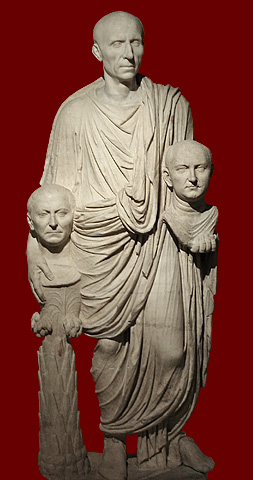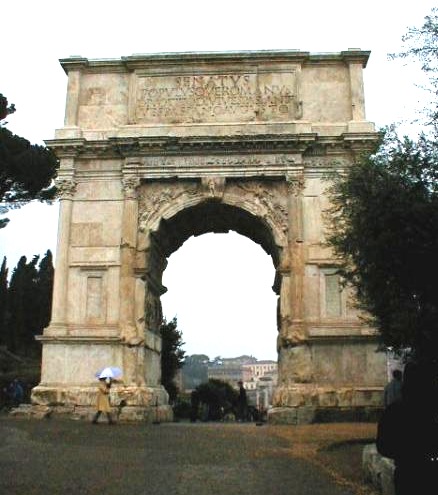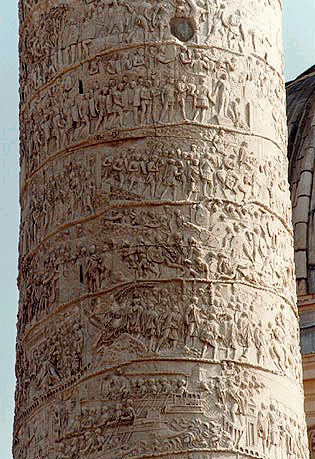Cards In This Set
| Front | Back |
|
THE EARLY EMPIRE, THE LATE EMPIRE
|
The Early Empire: during the age of Augustus, Roman portrait sculpture turned from the earlier veristic style of the Republic to a more classicizing style associated with ancient Greece
The Late Empire: not long after the death of Marcus Aurelius, the Roman Empire entered a period of instability that lasted almost 100 years; in late antiquity, an abstract style came to dominate Roman architecture and sculpture, possibly due to an increased interest in spirituality, and to changing concepts of rulership |
 |
Laocoon Group, 1st century CE
-date is questionable: powerful tension between the subject's agonizing death throes and a viewer's pleasure at the work's extraordinary quality -- caused an art historian to date it to the 4th century BCE, as part of the Classical period; however, some say it looks like it belongs in the Hellenistic era, some say it was even done by Michelangelo |
 |
Temple of Portunus, Rome; 80-70 BCE; ROMAN
-Italic style: stands on a podium and engaged lateral columns emphasize the frontal approach-the Ionic columns have the slender proportions of Classical Greek temples as well as the white marble stucco, which deliberately evoked the translucent marbles used by Greek architects-the practice of borrowing Greek forms began early in the Roman Republic-was constructed by a Greek architect, Hermodorus |
 |
Sanctuary of Fortuna Primigenia - located in Praeneste; early 1st century BCE; Roman
-sanctuary to the goddess Fortuna Primigenia-oracular center where priests interpreted divine will by drawing lots-seven levels each with different purposes |
 |
Togate male portrait with busts; late 1st century BCE; ROMAN
-probably holding busts of ancestors-Republican portrait-probably commemorative |
 |
Augustus of Primaporta, 20 CE; ROMAN (The Early Empire)
-Augustus was emperor during the Early Empire-Roman portrait sculpture turned from the earlier veristic style of the Republic to a more classicizing style associated with ancient Greece-until his death, portraits of Augustus depict him as an ageless youth-both the contrapposto stance and the smooth features of his face are strongly reminiscent of Doryphoros from the Greek Classical Age-shows the tendency in Roman art to express a message through references to earlier works (Cupid, dolphin, breastplate) - by associating Augustus with historical or divine figures, these references projected an image of earthly and divinely ordained power, thereby elevating the emperor above other politicians |
 |
Portrait of Vespasian, 75 CE; ROMAN (Early Empire)
-back to veristic style of portrait (before this: idealistic; this: veristic; after this: back to idealistic) -differs from abstract quality found in late antiquity work-shows Vespasian realistically -- matter-of-fact like the strong and successful military man he was |
 |
Equestrian Statue of Marcus Aurelius; 161-180 CE; ROMAN (Early Empire)
-beginning in the 2nd century CE, Roman portraits gradually take on a more abstract quality -- seen in this portrait of Marcus Aurelius - eyes: heavy lids = remote quality-not idealized |
 |
Ara Pacis Augustae, west facade. 13-9 BCE; ROMAN
-The Republican practice of commissioning narrative reliefs to record specific events continued well into the Empire - they were mounted on public buildings and monuments - like the Ara Pacis Augustae-relief panels represent allegorical figures, or personifications, and figures from Rome's legendary past-deeply political art -- characterizes much of Roman art |
 |
Imperial procession south frieze at the Ara Pacis Augustae, 13-9 BCE; ROMAN
-deeply political art, which characterizes much of Roman art-seems to record a particular event-in their superficial resemblance to the Greek Parthenon frieze, they bear witness, once again, to the preference for Greek styles in the age of Augustus |
 |
Arch of Titus, Rome, 81 CE; ROMAN
-stands at the far eastern end of the Roman Forum-earliest surviving free-standing arch in Rome-could have been a triumphal monument but it is more likely that it commemorates Titus' divinization after his death-reliefs located inside the bay |
 |
Relief in bay of Arch of Titus, showing procession of spoils from the Temple in Jerusalem, 81 CE; ROMAN
-the panel marks an important move toward illusionism in the portrayal of space - two ranks of figures appear, carved in different levels of relief; background figures seem to fade into the distance; seems to continue beyond a viewer's line of sight because the procession breaks away abruptly at the sides-illusion of SPACIAL DEPTH-panel even bulges out slightly in the center -- so that it seems to turn right in front of a viewer situated inside the arch's bay, making the viewer a part of the action |
 |
Relief in bay of Arch of Titus, showing Titus riding in triumph, 81 CE?; ROMAN
-differing levels of relief-horses appear in profile but chariot is frontal - giving the illusion that the procession is coming towards the viewer before turning sharply -- not realistic but artist wanted to show that there were 4 horses-Vespasian's absence shows how Roman visual narratives are not always historically accurate depictions of events --> they are made to express a version of events that serves the patron's ideology |
 |
Column of Trajan, Rome. 106-113 CE; ROMAN
-exploration of space and narrative-there is a 656-foot continuous narrative relief that winds around the column -- celebrating the emperor's victorious campaigns against the Dacians-combats rarely occur in the many scenes of the relief -- the geographic, logistic, and political aspects of the campaign receive more attention-still part of the classicizing phase of Roman sculpture |
 |
Relief on the column of Trajan, Rome; 106-113 CE; Roman
-celebrating the emperor's victorious campaigns against the Dacians-combats rarely occur in the many scenes of the relief -- the geographic, logistic, and political aspects of the campaign receive more attention-still part of the classicizing phase of Roman sculpture-relief = formulaic; stock scenes are repeated again and again |



